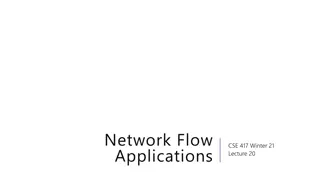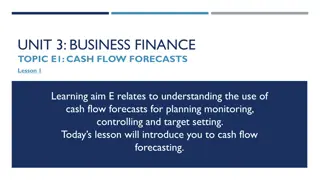The Psychology of Flow: Achieving Total Focus and Optimal Performance
Engage in activities for their intrinsic value, where the ego diminishes, and time seems to vanish - that's when flow occurs. This optimal psychological state involves deep concentration, clear goals, and a sense of control. By embracing challenges and staying in the present moment, one can cultivat
0 views • 13 slides
Runoff in Hydrology
Runoff in hydrology refers to surface water flow from precipitation and other sources in drainage basins. It plays a crucial role in stream flow and peak flood formation, influenced by factors like overland flow, interflow, and groundwater flow. This article explores the sources of runoff, including
3 views • 27 slides
Max Flow in Network Theory
In network theory, understanding the concept of maximum flow is crucial. From finding paths to pushing flow along edges, every step contributes to maximizing the flow from a source to a target in the graph. The process involves determining capacities, creating flows, and calculating the net flow ent
2 views • 41 slides
Fire Flow Requirements and Calculation Methods
Detailed information on site fire flow and hydrant flow testing requirements, how to calculate required fire flow, applicable codes and standards including NFPA and IBC, duration of fire flow, methodologies for fire flow calculation, and ISO methods and formulas.
4 views • 30 slides
Importance of Cash Flow Analysis in Financial Management
Cash flow analysis is a crucial financial tool for effective cash management, aiding in evaluating financial policies and positions. It helps in planning, coordinating financial operations, assessing cash needs, and meeting obligations. However, it has limitations as it does not substitute the incom
3 views • 7 slides
Fluid Flows in Fluid Mechanics
Fluid Mechanics is the study of fluids in motion or at rest, and their interactions with solids or other fluids. Fluid flows are classified based on various characteristics such as viscous versus inviscid regions, internal versus external flow, compressible versus incompressible flow, laminar versus
1 views • 16 slides
Flow Monitoring in OVS for Efficient Network Management
Learn how Flow Monitoring in Open vSwitch (OVS) allows controllers to track and manage changes to flow tables, enabling efficient network management. Explore topics such as Flow Mod programming, Flow Monitor messages, OVS support, monitoring vs. snoop, and practical examples of flow monitoring in ac
1 views • 9 slides
Recommended Maximum Heart Rate Formula Adjustment Analysis
The recommended maximum heart rate formula has been updated from 220 - age to 208 * (0.7 * age). This alteration results in a slight decrease in maximum heart rate for young individuals and a slight increase for older individuals. We aim to determine the age at which the new formula causes an increa
0 views • 10 slides
Enhancing TCP Performance: Understanding Maximum Window Size
Explore the concept of increasing the maximum window size of TCP to improve performance. Delve into discussions on the current limitations, proposals for enhancement, and the importance of understanding TCP sequencing. Discover insights on why the maximum window size must be less than 2^30 and wheth
1 views • 8 slides
Flow Chemistry for Efficient Chemical Reactions
Flow chemistry, also known as continuous flow or plug flow chemistry, revolutionizes chemical reactions by running them in a continuous flow stream. This dynamic process offers efficient manufacturing of chemical products with precise control over critical parameters like stoichiometry, mixing, temp
2 views • 7 slides
A Faster Algorithm for Linear Programming and the Maximum Flow Problem
A comprehensive overview of a new algorithm for linear programming and the maximum flow problem developed by Yin Tat Lee and Aaron Sidford from MIT and Simons. The algorithm aims to improve efficiency by reducing the number of iterations required to reach the optimal solution. It discusses the histo
0 views • 40 slides
Open Channel Flow and Mannings Equation
This review covers hydraulic devices such as orifices, weirs, sluice gates, siphons, and outlets for detention structures. It focuses on open channel flow, including uniform flow and varied flow, and explains how to use Mannings equation for calculations related to water depth, flow area, and veloci
1 views • 43 slides
Information-Agnostic Flow Scheduling: Minimizing FCT in Data Centers
This study explores information-agnostic flow scheduling for commodity data centers to minimize flow completion time (FCT) without prior knowledge of flow size. Existing solutions requiring prior flow size information are deemed infeasible for some applications and challenging to deploy in practice.
2 views • 46 slides
Network Flow and Linear Programming in Optimization Problems
Optimization problems involve instances with large solution sets and compute costs. Network flow optimization focuses on directed graphs, maximizing flow from source to sink through edges with capacities. The goal is to find the maximum flow while considering the Min Cut theorem. Algorithms are used
0 views • 45 slides
Network Flow Applications in CSE 417 Winter 21 Lecture 20
Explore the concept of network flow applications in CSE 417 Winter 21 Lecture 20, focusing on the Ford-Fulkerson algorithm for finding maximum flow and minimum cut in directed graphs. Discover the connection between max-flow and min-cut, and learn about the practical applications in assignment probl
1 views • 46 slides
Max-Flow and Min-Cut Problems in Graph Theory
This collection covers the concepts of max-flow and min-cut in directed graphs, focusing on moving water or data packets from a source to a target vertex within given capacities. It explains flow values, finding optimal solutions, and strategies for maximizing flow networks. The visuals aid in grasp
0 views • 58 slides
Fanno and Rayleigh Lines in Adiabatic Flow
Fanno and Rayleigh lines on the h-s diagram help in analyzing adiabatic flow with friction effects. The Fanno line represents frictional flow, while the Rayleigh line signifies non-adiabatic, frictionless flow. These lines aid in plotting flow properties and understanding phenomena like shock waves
0 views • 6 slides
Ford-Fulkerson Algorithm for Maximum Flow in Networks
The Ford-Fulkerson algorithm is used to find the maximum flow in a network by iteratively pushing flow along paths and updating residual capacities until no more augmenting paths are found. This algorithm is crucial for solving flow network problems, such as finding min-cuts and max-flow. By modelin
1 views • 26 slides
Cash Flow Forecasts in Business Finance
This lesson introduces cash flow forecasting in business finance, outlining the importance of predicting, monitoring, controlling, and setting targets for cash flow. It covers key terms, purpose of cash flow forecasting, cash inflows and outflows, and the structure of cash flow forecasts. Students w
1 views • 10 slides
Divide and Conquer Algorithms - Dr. Maram Bani Younes
This chapter on divide and conquer algorithms introduces key concepts such as dividing the problem into smaller subproblems, solving them, and combining the solutions. It covers techniques like finding maximum and minimum elements, maximum contiguous subsequence sum, binary search, quick sort, merge
1 views • 30 slides
Network Flows and Applications
Explore the concepts of network flows, including Ford-Fulkerson, maximum flow calculations, and handling complications like antiparallel edges. Learn about flow networks in various applications such as transportation and computer networks. Discover methods for adjusting flow graphs and assigning val
1 views • 40 slides
Indian Housing Block Grant 2023 Competitive Priorities
The Fiscal Year 2023 Indian Housing Block Grant (IHBG) Competitive NOFO Training focuses on Soundness of Approach with a maximum of 42 points. Subfactor 3.1 emphasizes IHBG Competitive Priorities, including new housing construction projects, housing rehabilitation projects, acquisition of units, and
0 views • 23 slides
Basic Hydraulic Flow Control Valves Overview: Types and Functions
Basic Hydraulic Flow Control Valves play a crucial role in regulating fluid flow in hydraulic systems. This comprehensive guide covers various types of flow control valves such as throttle valves dependent on viscosity, meter-in/meter-out/bypass flow control valves, and more. Learn about their funct
0 views • 15 slides
mass flow controllers (1)
The global mass flow controllers market is segmented by product type (thermal mass flow controllers, Coriolis mass flow controllers, differential pressure mass flow controllers), flow rate (low (0-50 slpm), medium (0-300 slpm), high (0-1500 slpm)), e
0 views • 5 slides
Fluid Flow and Measurement Devices
The concept of rotational and irrotational flow adjacent to a straight boundary, along with the dynamics of fluid flows and laws governing fluid flow like the continuity equation and energy equation, are discussed. Insights into devices for flow measurement such as venturimeter, pitot tube, orifices
0 views • 4 slides
Federal Sentencing Principles
Federal sentencing is determined by various factors including the applicable sentencing statute, statutory maximum and minimum terms of imprisonment, fines, supervised release terms, special assessments, the U.S. Sentencing Commission Guidelines Manual, judicial discretion, and factors outlined in 1
0 views • 26 slides
Flow Cytometry: Measuring Cell Properties
Flow cytometry is a technique used to measure various properties of cells as they flow in a fluid suspension. This method involves labeling biological samples with fluorescent markers and analyzing cells' size, complexity, and fluorescence intensity. By utilizing a focused light source and sensitive
1 views • 38 slides
Importance of Low-Flow and High-Flow Characteristics for Riparian Vegetation Restoration
This study examines the significance of low-flow and high-flow attributes in restoring riparian vegetation along arid rivers in the southwestern United States. The impact of climate, human activities, and river conditions on the vegetation is explored, highlighting the differences in low-flow and hi
0 views • 17 slides
Transportation Engineering
In this detailed analysis, we explore traffic characteristics in transportation engineering, focusing on speed-density relationships, flow calculations, and capacity estimations for roadway sections. The example scenarios provide insights into free-flow speed, jam density, speed-flow relationships,
0 views • 19 slides
NHDPlus V2 Mean Monthly and Low Flow Estimates
NHDPlus Version 2 includes mean annual flow and velocity estimates for all stream segments. The release now features mean monthly flow and velocity estimates as well as initial testing of 7Q10 flows. Learn about the methodology behind these estimates and the Enhanced Runoff Method (EROM) contributor
1 views • 28 slides
Rheology in Industrial Pharmacy: Flow Properties of Particles
Rheology in industrial pharmacy focuses on the flow properties of pharmacological particles, essential for the manufacturing of tablets and capsules. Understanding powder flowability, factors influencing flow rate, and types of powder flow are crucial in ensuring efficient production processes. Fact
0 views • 17 slides
Mastering Hydraulic Routing in Rivers: HEC-RAS Manual Insights
Dive deep into hydraulic routing in rivers with the HEC-RAS Manual, exploring topics like specific energy, critical flow, flood inundation, floodplain delineation, and steady flow solutions. Understand concepts such as flow conveyance, energy head loss, velocity coefficients, and solving steady flow
1 views • 12 slides
Analysis of Maximum Network Flow Algorithms
The tutorial explores the concept of maximum network flow and its applications in graph theory. It covers topics such as network flow capacity constraints, residual networks, augmenting paths, and the Ford-Fulkerson algorithm. The discussion includes the efficiency of different methods like Ford-Ful
0 views • 21 slides
The Art of Pacing How We Edit for Maximum Engagement
\/\/ \/the-art-of-pacing-how-we-edit-for-maximum-engagement\/\nThe Art of Pacing: Learn how to edit content for maximum engagement by mastering timing, flow, and rhythm to keep your audience hooked.\n
0 views • 4 slides
Understanding Maximum Likelihood and Maximum Entropy Duality
Explore the duality between Maximum Likelihood and Maximum Entropy in data modeling and prediction tasks, illustrated with examples and principles like Laplace's Principle of Unbiased reasoning.
2 views • 102 slides
Max Flow: Theory, Definitions, and Applications
Explore the world of maximum flow networks through definitions, the Ford-Fulkerson algorithm, residual graphs, augmenting paths, cuts, and their significance in solving the maximum flow problem. Understand how flows and cuts are interconnected and form the basis of various graph problems.
0 views • 28 slides
Network Simplex Method for Minimum-Cost Network Flow Problems
Learn about the Network Simplex Method, a powerful technique used to solve Minimum-Cost Network Flow Problems (MCNFP). Explore the formulation of MCNFP, including transportation and maximum flow problems, and understand how the method simplifies the simplex algorithm for efficient solutions. Dive in
0 views • 21 slides
CASE IH AXIAL-FLOW 7010 AXIAL-FLOW 7010 AXIAL-FLOW 8010 AXIAL-FLOW 8010 AXIAL-FLOW 9010 Combine Service Repair Manual Instant Download (Part Number 87486644)
CASE IH AXIAL-FLOW 7010 AXIAL-FLOW 7010 AXIAL-FLOW 8010 AXIAL-FLOW 8010 AXIAL-FLOW 9010 Combine Service Repair Manual Instant Download (Part Number 87486644)
0 views • 24 slides
Understanding Max Flow and Min Cut Networks
Explore the concepts of flow networks, flows, and the maximum flow problem in the context of graph theory. Learn about algorithms and definitions crucial for solving problems related to material flow optimization. Discover practical insights into constructing flow paths and finding the maximum value
0 views • 40 slides
Understanding Network Flow and Linear Programming in Optimization Problems
Dive into the world of network flow and linear programming, exploring optimization problems, instances, solutions, preconditions, postconditions, and the interplay between max flow and min cut theorems. Discover the intricacies of directing flow in a network, determining optimal solutions, and the r
0 views • 45 slides







































